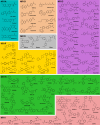Chemogenomics for NR1 nuclear hormone receptors
- PMID: 38890295
- PMCID: PMC11189487
- DOI: 10.1038/s41467-024-49493-6
Chemogenomics for NR1 nuclear hormone receptors
Abstract
Nuclear receptors (NRs) regulate transcription in response to ligand binding and NR modulation allows pharmacological control of gene expression. Although some NRs are relevant as drug targets, the NR1 family, which comprises 19 NRs binding to hormones, vitamins, and lipid metabolites, has only been partially explored from a translational perspective. To enable systematic target identification and validation for this protein family in phenotypic settings, we present an NR1 chemogenomic (CG) compound set optimized for complementary activity/selectivity profiles and chemical diversity. Based on broad profiling of candidates for specificity, toxicity, and off-target liabilities, sixty-nine comprehensively annotated NR1 agonists, antagonists and inverse agonists covering all members of the NR1 family and meeting potency and selectivity standards are included in the final NR1 CG set. Proof-of-concept application of this set reveals effects of NR1 members in autophagy, neuroinflammation and cancer cell death, and confirms the suitability of the set for target identification and validation.
© 2024. The Author(s).
Conflict of interest statement
The authors declare no competing interests.
Figures







Similar articles
-
Comparative Evaluation and Profiling of Chemical Tools for the Nuclear Hormone Receptor Family 2.ACS Pharmacol Transl Sci. 2025 Mar 14;8(3):854-870. doi: 10.1021/acsptsci.4c00719. Epub 2025 Feb 20. ACS Pharmacol Transl Sci. 2025. PMID: 40046426 Free PMC article.
-
Chemogenomics for steroid hormone receptors (NR3).Commun Chem. 2025 Feb 3;8(1):29. doi: 10.1038/s42004-025-01427-z. Commun Chem. 2025. PMID: 39900826 Free PMC article.
-
Compound profiling using a panel of steroid hormone receptor cell-based assays.J Biomol Screen. 2008 Sep;13(8):755-65. doi: 10.1177/1087057108322155. Epub 2008 Aug 27. J Biomol Screen. 2008. PMID: 18753690
-
Natural ligands for nuclear receptors: biology and potential therapeutic applications.Curr Top Med Chem. 2012;12(6):637-69. doi: 10.2174/156802612799436650. Curr Top Med Chem. 2012. PMID: 22242857 Review.
-
Classical nuclear hormone receptor activity as a mediator of complex biological responses: a look at health and disease.Best Pract Res Clin Endocrinol Metab. 2015 Aug;29(4):517-28. doi: 10.1016/j.beem.2015.07.005. Epub 2015 Jul 16. Best Pract Res Clin Endocrinol Metab. 2015. PMID: 26303080 Review.
Cited by
-
Bio-Pathological Functions of Posttranslational Modifications of Histological Biomarkers in Breast Cancer.Molecules. 2024 Sep 2;29(17):4156. doi: 10.3390/molecules29174156. Molecules. 2024. PMID: 39275004 Free PMC article. Review.
-
Comparative Evaluation and Profiling of Chemical Tools for the Nuclear Hormone Receptor Family 2.ACS Pharmacol Transl Sci. 2025 Mar 14;8(3):854-870. doi: 10.1021/acsptsci.4c00719. Epub 2025 Feb 20. ACS Pharmacol Transl Sci. 2025. PMID: 40046426 Free PMC article.
-
Toward target 2035: EUbOPEN - a public-private partnership to enable & unlock biology in the open.RSC Med Chem. 2024 Nov 29;16(2):457-464. doi: 10.1039/d4md00735b. eCollection 2025 Feb 19. RSC Med Chem. 2024. PMID: 39618964 Free PMC article.
-
Chemogenomics for steroid hormone receptors (NR3).Commun Chem. 2025 Feb 3;8(1):29. doi: 10.1038/s42004-025-01427-z. Commun Chem. 2025. PMID: 39900826 Free PMC article.
-
Agonists of the Nuclear Receptor PPARγ Can Produce Biased Signaling.Mol Pharmacol. 2024 Nov 18;106(6):309-318. doi: 10.1124/molpharm.124.000992. Mol Pharmacol. 2024. PMID: 39443155 Free PMC article.
References
MeSH terms
Substances
Grants and funding
- 875510/Innovative Medicines Initiative (IMI)
- 875510/Innovative Medicines Initiative (IMI)
- 101040355/EC | EU Framework Programme for Research and Innovation H2020 | H2020 Priority Excellent Science | H2020 European Research Council (H2020 Excellent Science - European Research Council)
- 515275293/Deutsche Forschungsgemeinschaft (German Research Foundation)
- 512574446/Deutsche Forschungsgemeinschaft (German Research Foundation)
LinkOut - more resources
Full Text Sources

